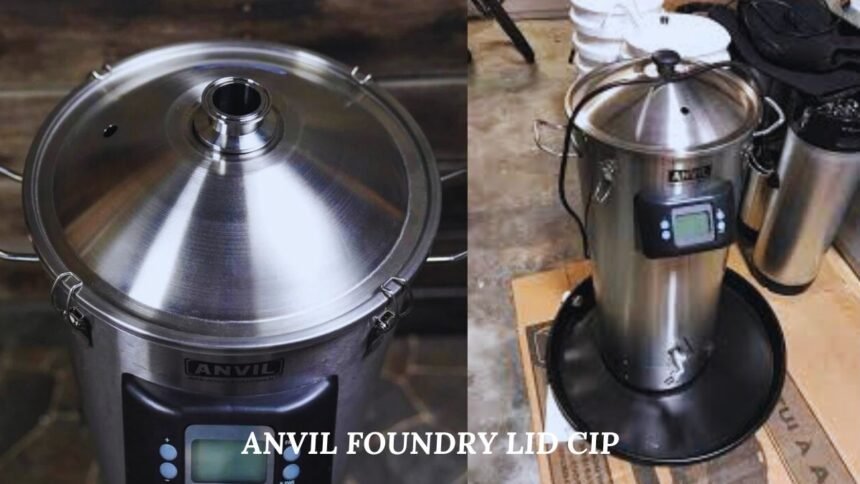Maintaining your Anvil Foundry brewing system is crucial for consistent brewing results. One of the key aspects of this maintenance is the lid Clean-In-Place (CIP) process. This guide provides an in-depth look into the Anvil Foundry lid CIP, ensuring your brewing setup remains in top condition.
Introduction
Brewing enthusiasts understand the importance of cleanliness in brewing operations. The Anvil Foundry lid CIP (Clean-In-Place) is a critical component in ensuring your brewing system stays hygienic and efficient. This article dives into the intricacies of the CIP process, offering detailed insights and practical advice to keep your Anvil Foundry lid in optimal working order.
What is Anvil Foundry Lid CIP?
Anvil Foundry is a popular all-in-one brewing system designed for home brewers who demand precision, flexibility, and ease of use. It provides everything needed to brew various beer styles, making it a favored choice among both beginners and experienced brewers.
Importance of Lid Maintenance
Maintaining the Anvil Foundry lid is essential for preventing contamination and ensuring the longevity of your equipment. Regular CIP processes help remove residues and prevent buildup that can affect the taste and quality of your brews.
Anvil Foundry Lid CIP: A Detailed Overview
Clean-In-Place (CIP) is a method used to clean the interior surfaces of brewing equipment without disassembly. For the Anvil Foundry lid, CIP involves using cleaning solutions and processes that effectively sanitize the lid and connected components.
Step-by-Step Guide to Anvil Foundry Lid CIP
Cleaning the Anvil Foundry lid involves several steps to ensure thorough sanitation. Here’s a comprehensive guide:
Preparation
Before starting the CIP process, gather all necessary materials, including cleaning solutions, brushes, and protective gear.
Initial Rinse
Begin by rinsing the lid with hot water to remove loose debris and residues. This step prepares the lid for the application of cleaning agents.
Application of Cleaning Solution
Apply a suitable cleaning solution designed for brewing equipment. Ensure the solution covers all surfaces of the lid, including hard-to-reach areas.
Scrubbing and Agitation
Use a brush to scrub the lid thoroughly, focusing on areas where residues are most likely to accumulate. Agitation helps in loosening stubborn deposits.
Final Rinse
Rinse the lid with clean, hot water to remove all traces of the cleaning solution. Ensure no residues are left behind.
Sanitization
Apply a sanitizing solution to the lid to kill any remaining bacteria or yeast. Allow the solution to sit for the recommended time before rinsing again with clean water.
Best Cleaning Agents for Anvil Foundry Lid CIP
Choosing the right cleaning agents is crucial for effective CIP. Some recommended products include PBW (Powdered Brewery Wash), Star San, and other brewing-specific cleaners.
Common Mistakes to Avoid
When performing lid CIP, avoid these common mistakes:
- Using incorrect cleaning agents that can damage the lid material
- Insufficient rinsing, leading to residue buildup
- Skipping the sanitization step, which can result in contamination
Benefits of Regular Lid CIP
Regular lid CIP offers several benefits:
- Prolongs the lifespan of your Anvil Foundry
- Ensures consistent brew quality
- Reduces the risk of contamination and off-flavors
Troubleshooting CIP Issues
Occasionally, you might encounter issues during the CIP process. Common problems include:
- Stubborn residues that don’t come off easily
- Lingering odors after cleaning
- Corrosion or wear on the lid surface
Maintenance Schedule for Anvil Foundry Lid
Establishing a regular maintenance schedule is key. Ideally, perform a thorough lid CIP after every brewing session to maintain optimal hygiene.
Upgrading Your Anvil Foundry for Easier CIP
Consider upgrading components or adding accessories that simplify the CIP process. Quick disconnects and spray balls can make cleaning more efficient.
Expert Tips for Effective Lid CIP
- Always wear protective gear when handling cleaning agents
- Use warm water for rinsing, as it is more effective at dissolving residues
- Rotate your cleaning agents periodically to prevent resistance buildup
Case Study: Improved Brew Quality Through Proper CIP
Many brewers have reported significant improvements in their brew quality after implementing a strict CIP regimen for their Anvil Foundry lids. Cleaner equipment directly correlates with better-tasting beer.
The Role of Technology in CIP
Advancements in brewing technology have introduced automated CIP systems. These systems offer precise control over cleaning parameters, ensuring thorough and consistent sanitation.
Conclusion
Maintaining your Anvil Foundry lid CIP is essential for brewing high-quality beer. By following the detailed steps and tips provided in this guide, you can ensure your brewing system remains in top condition, resulting in consistently excellent brews.
FAQs
What is the Anvil Foundry lid CIP process? The Anvil Foundry lid CIP process involves cleaning the lid with specialized solutions to remove residues and sanitize it, ensuring it remains hygienic for brewing.
How often should I perform CIP on my Anvil Foundry lid? It’s recommended to perform CIP after every brewing session to maintain optimal hygiene and prevent contamination.
Can I use household cleaning agents for CIP? No, it’s best to use cleaning agents specifically designed for brewing equipment, such as PBW or Star San, to avoid damaging your equipment.
What if there are stubborn residues on the lid? Use a brush and a suitable cleaning solution to scrub the lid. For stubborn residues, soak the lid in the cleaning solution for an extended period.
Is sanitization necessary after cleaning the lid? Yes, sanitization is crucial to kill any remaining bacteria or yeast, ensuring the lid is safe for the next brewing session.
Can I automate the CIP process? Yes, there are automated CIP systems available that offer precise control over the cleaning process, making it more efficient and consistent.
